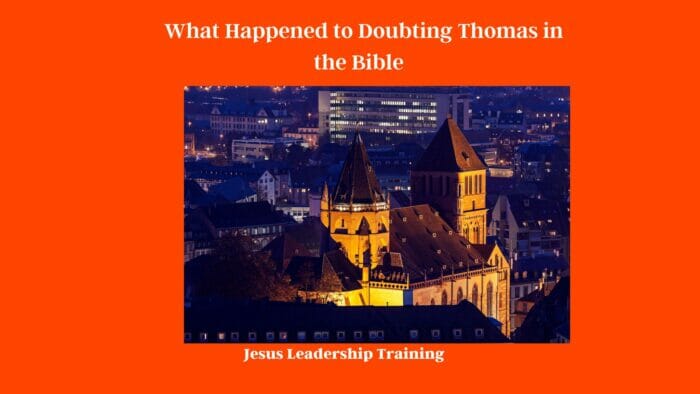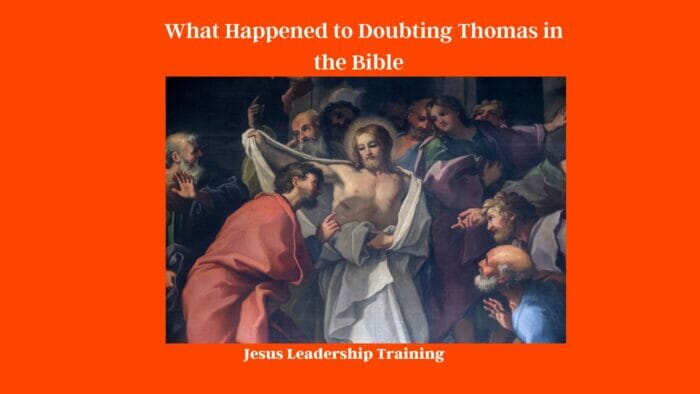What happened to Doubting Thomas in the Bible, we journey through the transformative narrative of an Apostle who moved from skepticism to profound faith. Thomas, initially questioning the Resurrection of Jesus Christ, only believed upon seeing and touching the wounds of the risen Christ. His subsequent proclamation, “My Lord and my God!” marks a momentous transition, making him a significant figure in Christian theology and serving as a beacon of hope for seekers grappling with doubt.
Post-Resurrection, Thomas undertook numerous missionary journeys, spreading the teachings of Christ even to distant lands like India. Despite the initial doubt, Thomas’s journey, culminating in martyrdom, has left a significant impact on religious doctrine, art, literature, and popular culture, rendering his narrative a timeless parable for our modern, skeptical era.
Table of Contents
What Happened to Doubting Thomas in the Bible
In the vast tapestry of biblical narratives, the tale of Thomas, commonly known as Doubting Thomas, has forever fascinated theologians, scholars, and believers alike. But who was Thomas, and more importantly, what happened to Doubting Thomas in the Bible? Let’s unravel this fascinating chronicle of skepticism and faith.
Unraveling the Mystery: How Many Apostles Did Jesus Have | Jesus | Disciples | Christ

Traditions concerning the Life of Thomas the Apostle
Certainly, here’s a table that provides information about various traditions associated with the life of Thomas the Apostle:
| Tradition | Description |
|---|---|
| Doubting Thomas | The event in which Thomas doubted the resurrection of Jesus (John 20:24-29) until he saw and touched the wounds of Jesus is widely commemorated in Christian tradition. |
| Missionary Journey to India | The most significant tradition associated with Thomas is his missionary journey to India, particularly to the Kerala region. The St. Thomas Christian communities in India trace their origins to this apostolic foundation. |
| Thomas’ Martyrdom | Thomas is traditionally believed to have been martyred in Mylapore (in present-day Chennai, India). He was reportedly killed by a spear for his Christian faith and is thus often depicted with a spear. |
| Gospel of Thomas | A non-canonical Gospel, the Gospel of Thomas, is ascribed to Thomas, though its authenticity is not accepted by the mainstream Christian tradition. |
| Builder of Churches | In some traditions, especially within the Syrian Christian communities, Thomas is known for his skill as a builder and architect. |
| Feast of St. Thomas | His feast day is celebrated on July 3rd in the Roman Catholic Church, and on October 6th in the Eastern Orthodox Church. |
These traditions about Thomas the Apostle have been shaped and passed down through centuries, and they continue to have a significant influence in various Christian communities worldwide.

Lessons we can Learn from Thomas in the Bible
Sure, here’s a table that presents some spiritual lessons we can learn from the life of Thomas in the Bible:
| Lesson | Description |
|---|---|
| Value of Doubt | Thomas’s doubts about Jesus’ resurrection (John 20:24-29) teach us that doubt can be a part of faith journey. It’s okay to question and seek evidence, as it can lead to a deeper and stronger faith. |
| Personal Encounter with Jesus | When Jesus invited Thomas to touch his wounds, it showed that faith can be deepened through personal encounters with God, rather than through hearsay. |
| Boldness in Faith | Thomas was willing to die with Jesus (John 11:16), which demonstrates a level of boldness and loyalty that we can emulate in our faith journey. |
| Proclaiming Faith | Once Thomas had seen the resurrected Christ, he made one of the clearest proclamations of Jesus’ divine nature, “My Lord and my God!” (John 20:28). This encourages us to openly acknowledge our belief. |
| Missionary Zeal | Tradition states that Thomas traveled to India to spread the Gospel, indicating a great passion for evangelism that believers can aspire to. |
| Resilience in Persecution | Thomas is traditionally believed to have been martyred for his faith, a reminder to stand firm in our beliefs, even when faced with persecution or hardship. |
The story of Thomas provides a profound message of the transformative power of personal encounter with Jesus, the role of doubt in faith journey, and the importance of bold proclamation of faith.

10 Spiritual Ways to Change Doubt to Faith
Sure, here is a table of spiritual ways to change doubt into faith:
| Step | Action | Explanation |
|---|---|---|
| 1. Acknowledge Your Doubt | Be honest about your feelings. | Doubt is not unusual or unforgivable. Many Biblical figures experienced doubt. Recognizing doubt can be the first step towards building a stronger faith. |
| 2. Seek Knowledge | Read the Bible, other religious texts, or literature about faith. | Understanding your faith at a deeper level can answer questions that may be causing doubt. |
| 3. Prayer | Have a regular prayer practice. | Communicate your feelings of doubt to God in prayer. Ask for guidance, clarity, and increased faith. |
| 4. Fellowship | Engage with a faith community. | Others may have experienced similar doubts and can provide support, perspective, and guidance. |
| 5. Service | Serve others in your community. | Service can connect you with the core values of your faith and reinforce your beliefs. |
| 6. Reflection | Spend time reflecting on instances where you have seen or felt the presence of God. | This can reinforce your faith and challenge doubts. |
| 7. Seek Spiritual Guidance | Speak to spiritual leaders or mentors. | They may provide insight, reassurance, and guidance about your doubts. |
| 8. Patience | Allow your faith to grow over time. | Spiritual growth often comes in stages and may require patience. Keep seeking, praying, and serving. |
| 9. Meditation | Practice religious or spiritual meditation. | This can bring spiritual clarity, peace, and a deeper connection to your faith. |
| 10. Scriptures Memorization | Memorize uplifting and faith-strengthening scriptures. | This can serve as a constant reminder of God’s promises and boost your faith when doubts arise. |
These steps are not necessarily linear. They can be taken as needed and repeated as often as necessary. The key is to maintain an open heart and mind as you continue your spiritual journey from doubt to faith.
Thomas: A Brief Introduction
Before we delve into the crux of the matter, it’s important to lay the groundwork. Who was this man, Thomas, whose name now symbolizes skepticism in modern parlance? Thomas, also known as Didymus, was one of the Twelve Apostles of Jesus Christ. His tale is one of transformation – from skepticism to faith.
The Incidence of Doubt: A Closer Look
The moniker ‘Doubting Thomas’ finds its roots in an incident following the Resurrection of Jesus Christ. In the aftermath of Jesus’ crucifixion and resurrection, Thomas expressed his doubts about the event, voicing his skepticism about his fellow disciples’ accounts of encountering the risen Christ.
Doubting Thomas in the Bible: A Re-examination
So, what happened to Doubting Thomas in the Bible? The term ‘Doubting Thomas’ stems from the Gospel of John, where Thomas famously expresses his skepticism about Jesus’ resurrection until he could see and touch Jesus’ wounds. This is where Thomas’ journey really begins.
The Proclamation of Doubt
As per the account in John 20:25, when the disciples tell Thomas they have seen the Lord, he replies, “Unless I see the nail marks in his hands and put my finger where the nails were, and put my hand into his side, I will not believe.” This proclamation sets the stage for Thomas’s subsequent transformation.
Jesus Appears to Thomas: A Pivotal Moment
The narrative reaches a crucial juncture when, eight days later, Jesus appears to Thomas. Addressing his doubts, Jesus encourages Thomas to touch his wounds and admonishes him for his unbelief, asking him to stop doubting and believe. This encounter dramatically shifts Thomas’s perspective.
Thomas’s Confession of Faith
Thomas’s response to Jesus’ invitation constitutes one of the most profound confessions of faith in the entire New Testament. He exclaims, “My Lord and my God!” This moment symbolizes Thomas’s transition from doubt to unwavering belief, affirming his faith in the resurrected Christ.
What Happened to Doubting Thomas in the Bible: Post-Resurrection
Following his transformative encounter with the resurrected Jesus, Thomas, like the other apostles, plays a vital role in spreading Christ’s teachings. There are several accounts of his journeys, with stories of his travels to far-off places, spreading the Good News.
Thomas’s Missionary Journeys
As per historical and religious accounts, Thomas embarked on several missionary journeys after Jesus’s Ascension. Some reports suggest that he traveled as far as India, where he established numerous Christian communities that still exist today.
Thomas’s Martyrdom
Just as the lives of many Apostles, Thomas’s journey, too, ended in martyrdom. His strong belief in Christ and unwavering commitment to propagate the Christian faith led to his death. However, accounts of how and where this occurred vary.
Legacy of Doubting Thomas
Despite his initial doubts, Thomas left behind a significant legacy. His story of transformation has not only shaped Christian theology but has also served as a beacon of hope and reassurance for those wrestling with doubts and skepticism.
Interpreting Doubt: Thomas’s Modern Relevance
While Thomas’s doubt is often viewed negatively, many theologians argue that it has a positive aspect. Doubt can lead to exploration and deeper understanding, and Thomas’s story exemplifies this, providing a critical lesson about faith and doubt’s complex interplay.
Doubting Thomas: A Parable for Our Times
In an era brimming with skepticism, the narrative of Doubting Thomas holds a particular resonance. His journey from doubt to belief acts as a powerful parable for modern times, highlighting the value of questioning, seeking evidence, and finding personal conviction.
Thomas in Christian Art and Symbolism
Thomas’s story has greatly influenced Christian art and symbolism. Many paintings and sculptures depict the significant moment when Thomas touches Jesus’ wounds, embodying his transition from skepticism to faith.
The Influence of Thomas’s Tale on Literature and Pop Culture
Beyond religious circles, the tale of Doubting Thomas permeates literature and pop culture, becoming a metaphor for skepticism. From literary classics to contemporary works, the ‘Doubting Thomas’ trope is commonly used to represent a skeptic who needs empirical evidence to believe in something.
What Happened to Doubting Thomas in the Bible: A Contemporary Reading
In our contemporary context, Thomas’s story offers a nuanced understanding of faith, doubt, and belief. His journey is not just a story from a bygone era, but a timeless narrative offering valuable insights into the human experience of faith and doubt.
Final Thoughts: The Transformation of Doubting Thomas
Thomas’s story is a powerful testament to the transformative power of faith. From his initial skepticism to his ultimate declaration of faith, his journey embodies the potential for doubt to serve as a pathway to deeper belief. The story of what happened to Doubting Thomas in the Bible stands as a timeless narrative of faith’s triumph over skepticism.
Meaning of the Name Thomas
The etymology of the biblical name Thomas is one that has been debated for centuries. Although the exact origin of the name is unknown, there are several theories as to its roots. In this blog, we will explore the possible origins of the name Thomas, including its Hebrew, Greek, Aramaic, and Latin roots.
Origin
The origin of the name Thomas is unclear. One theory is that it is derived from the Hebrew name תוֹחָם (Toham) which means “twin”. The name would then have been used to refer to a set of twins, or to someone who was like a twin.
Hebrew
The Hebrew name תוֹחָם (Toham) is derived from the root תוֹחָם (taham), meaning “twin”. It’s possible that the name Thomas was derived from this root, as it is associated with the concept of “twin”.
Greek
The Greek form of the name Thomas is Θωμάς (Thōmas), derived from the verb θέω (théō), meaning “to twin”. This would suggest that the name Thomas was originally associated with the concept of being a twin, or having a twin-like quality.
Aramaic
The Aramaic form of the name Thomas is Ṯāwma, derived from the root ṯwm, meaning “twin”. This would suggest that the name Thomas was derived from the concept of being a twin, or having a twin-like quality.
Latin
The Latin form of the name Thomas is Thomas, derived from the Greek form Θωμάς (Thōmas). This suggests that the name was derived from the Greek verb θέω (théō), meaning “to twin”.
In conclusion, the origin of the biblical name Thomas is uncertain, but there are several theories as to its roots. It is possible that the name originated in Hebrew, Greek, Aramaic, or Latin, all of which associate the name Thomas with the concept of being a twin, or having a twin-like quality.
Table of Names that come from the Biblical name of Thomas
Certainly, here’s a table that lists several names that have been derived from the Biblical name “Thomas”:
| Name | Language/Culture | Gender | Meaning |
|---|---|---|---|
| Thomas | English, French, German, Dutch, Swedish, Norwegian, Danish, Greek | Male | “Twin” |
| Tomás | Spanish, Irish, Portuguese | Male | “Twin” |
| Tommaso | Italian | Male | “Twin” |
| Tomé | Portuguese | Male | “Twin” |
| Tamás | Hungarian | Male | “Twin” |
| Toma | Serbian, Bulgarian, Macedonian, Croatian, Romanian, Georgian, Arabic | Male | “Twin” |
| Tuomas | Finnish | Male | “Twin” |
| Tomas | Lithuanian, Swedish, Norwegian, Danish | Male | “Twin” |
| Tomasz | Polish | Male | “Twin” |
| Tomislav | Croatian, Serbian, Slovene, Macedonian | Male | “Twin” and “Glory” |
These variations primarily reflect pronunciation and spelling conventions in different languages and cultures. The core meaning of “Thomas” as “Twin” remains consistent across the variations.
6 Positive Results of Doubt in the Bible
Sure, here’s a table that presents some instances in the Bible where doubt led to positive results:
| Character | Doubt | Positive Result |
|---|---|---|
| Thomas | Thomas doubted Jesus’ resurrection until he could see and touch Jesus himself (John 20:24-29). | His doubt led to one of the most clear affirmations of Jesus’ divinity in the New Testament: “My Lord and my God!” |
| Abraham | Abraham doubted that he would have a son in his old age (Genesis 17:17). | His doubt was met with a reaffirmation of God’s promise, and Abraham became the father of many nations. |
| Gideon | Gideon doubted his calling to lead Israel against the Midianites and asked for signs from God (Judges 6:36-40). | His doubt led to assurance from God, and he led Israel to victory. |
| Moses | Moses doubted his ability to lead the Israelites out of Egypt (Exodus 4:10). | His doubt led to God providing him with support in the form of his brother, Aaron, and Moses went on to lead his people to freedom. |
| Mary, mother of Jesus | Mary questioned how she, a virgin, could give birth to the Son of God (Luke 1:34). | Her questioning led to the angel Gabriel explaining the miraculous nature of Jesus’ conception, strengthening her faith and understanding. |
| Sarah | Sarah doubted God’s promise that she would bear a son in her old age (Genesis 18:12). | Despite her doubt, God fulfilled his promise and Sarah bore Isaac, who played a crucial role in God’s plan. |
The Bible suggests that doubts can often lead to greater understanding and deeper faith. In each of these instances, the individual’s doubt led to God responding with reassurance, clarification, or evidence of His divine power and faithfulness. Doubts can provoke questioning and deeper exploration of faith, leading to spiritual growth and maturity.
6 Negative Results of Doubt in the Bible
Absolutely, here’s a table that represents some instances in the Bible where doubt led to negative results:
| Character | Doubt | Negative Result |
|---|---|---|
| Eve | Eve doubted God’s word about the forbidden fruit (Genesis 3:1-6). | Her doubt led to the Fall of Man, resulting in sin entering the world. |
| Lot’s Wife | Despite being told not to, Lot’s wife looked back at the city of Sodom doubtfully (Genesis 19:26). | Her doubt led to her transformation into a pillar of salt. |
| The Israelites | The Israelites doubted God’s ability to lead them to the Promised Land (Numbers 14:1-4). | Their doubt resulted in a 40-year journey in the wilderness, and the older generation was not allowed to enter the Promised Land. |
| Peter | Peter doubted Jesus when he attempted to walk on water and became afraid (Matthew 14:28-31). | His doubt caused him to sink, demonstrating the dangers of weak faith. |
| Saul (later Paul) | Saul doubted the legitimacy of Jesus’ followers and persecuted them (Acts 9:1-2). | His actions resulted in a dramatic intervention by Jesus and temporary blindness. |
| Judas Iscariot | Judas doubted Jesus was the Messiah and betrayed Him (Matthew 26:14-16). | His doubt led to his own despair and suicide. |
In each of these instances, doubt led to significant negative consequences, often leading to suffering, hardship, and in some cases, death. The Bible often contrasts faith with doubt to demonstrate the importance of trust and belief in God’s word and promises.
FAQs
- Who was Doubting Thomas?
Doubting Thomas was an Apostle of Jesus Christ. He famously expressed his skepticism about Jesus’ resurrection until he personally saw and touched Jesus’ wounds. - What did Doubting Thomas say that led to his name?
When told about Jesus’ resurrection, Thomas responded, “Unless I see the nail marks in his hands and put my finger where the nails were, and put my hand into his side, I will not believe.” This gave rise to the term ‘Doubting Thomas.’ - How did Jesus respond to Thomas’s doubt?
Jesus appeared to Thomas and invited him to touch his wounds, saying, “Stop doubting and believe.” This marked a turning point in Thomas’s faith journey. - What happened to Doubting Thomas after he saw Jesus?
After his encounter with the resurrected Jesus, Thomas became a fervent believer and embarked on several missionary journeys, even reportedly reaching India. - How did Thomas die?
Thomas died a martyr, though the exact circumstances of his death vary among different accounts. - What is the significance of Thomas’s story today?
Thomas’s journey from doubt to belief offers valuable insights into the human experience of faith and doubt. His story serves as a powerful metaphor for the transformative power of faith.




